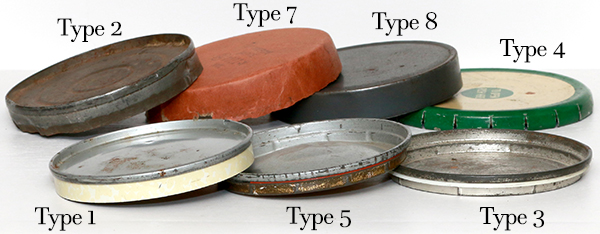The type of lid (top) is a very important factor in determining a can’s desirability.

USA CANS
The best cans are those that were made in the USA and have what collectors refer to as a “flat lid”. Actually the can doesn’t have much of a lid at all. Once the can is opened by its key, the top of the can (lid) will not go back onto the can. This accounts for most opened flat lid cans missing their tops. A flat lid can that is missing it’s top looks like it was cut off with tin snips. The newer more common USA cans have a lid with a slight dome shape to it. A dome lid will go back onto an opened can and stay on tight to hold the balls safely in the can (these are often mistakenly thought to be “unopened” by novice collectors and sellers). 1942-1945 (during WWII) is the approximate date that manufacturers changed from flat to domed lids in the USA
UNITED KINGDOM CANS
Most cans from the UK had flat lids whether they are old or new and should not be confused with the rare flat lid American cans. However there is a way to tell an old UK can from a new one. The old style UK cans have a similar top and bottom like the flat US cans and will have a solder spot in the lid or on the bottom of the can. Air pressure was put in through a small hole and then soldered shut. Newer UK key cans still have a flat lid, however it has more of a recess – about Both styles of UK lids will go back onto the can after opening. A semi rare type of can is the one that had a metal cap (Type 4). Printed on the cap is “Remove this cap, press inner disc firmly to release” The metal cap was pried off by hand and then an inner disc was pressed to expose the contents of the can.
There are at least two and maybe 3 different lids found on old UK (solder spot cans). One has two circular indentions and the other has none (smooth surface) (thoughts are that these either had two rings or none at all). See the article on Type Definitions for more information.
- Special thanks to Larry Whitaker for his input on lids.